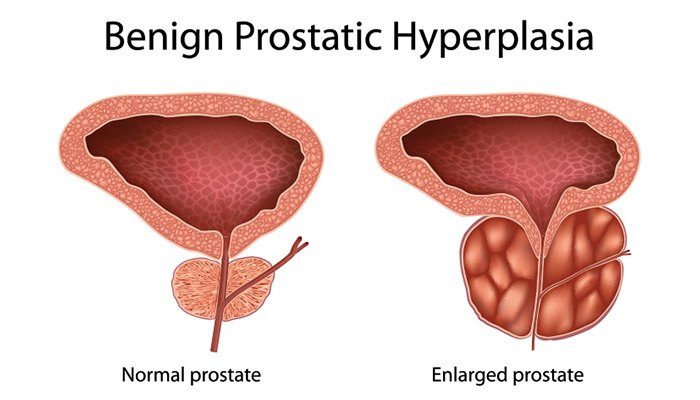You just retired from work and realized you have aged. You also haven’t felt good passing urine at times and you know there have been changes in the process of urination. This could be a benign prostatic hyperplasia, and no complaint relating to urination should be ignored.
About benign prostatic hyperplasia
Benign prostatic hyperplasia (BPH), also called benign prostatic hypertrophy is an enlargement of the prostate gland. This occurs as a part of normal ageing process and is common in elderly men. The prostate is known to grow throughout a man’s life. It grows significantly at two times in life. First, it enlarges during puberty when it doubles in size and second, it enlarges later in life when it causes symptoms at the age of 40 years or more. Half of the men in their sixties will have symptoms due to an enlarged prostate. This enlargement that occurs later in life causes the prostate to press upon the urinary bladder or urethra, the tube through which urine is passed out. It can impede the passage of urine and lead to problems of the urethra, bladder, or kidneys. BPH is neither a cancer nor does it increase the risk of cancer of the prostate.
Symptoms
The commonest symptoms of BPH are those relating to urination. The frequency, urgency, and ease of passage of urine may change. There may be more frequent urination, more so in the night, and this may disturb sleep. Some people experience urgency, a pressing need to pass urine and cannot hold urine for a while. Others experience leaking or dribbling, when urine passes without an effort made to do so. There may be difficulty in starting urination and one may need to strain more to pass urine. While evacuating the bladder, the stream of urine may either not form or may be weak or interrupted. Even after passing urine, there may be a feeling to pass some more. Sometimes, it may take more than one effort to get an easy feeling of an empty bladder.
Sometimes, the affected person may just fail to pass any urine at all and this may be painful. This is called acute urinary retention. Left unattended, the problems can grow to a urinary tract infection when there is burning and pain in urination, fever, and distress. Stones may form in the urinary tract and either due to irritation by a stone or consequent to damage to blood vessels due to increasing pressures in the urinary tract, there can be blood in urine.
The symptoms are not governed by the size of the prostate. A very large gland may cause little or no complaints and a smaller gland can cause distressing symptoms.
Risk Factor
The only certain risk factor for BPH is aging. No other risk factors have been identified. It may run in families when several men in a family may be affected. BPH is more common in whites than blacks.
The actual cause for BPH is not known. It is not known to occur in men who have the gonads called testes removed. BPH is believed to occur due to changing hormonal milieu in men as they age. The levels of the male hormone, testosterone fall during aging and the levels of female hormone, estrogen begin to rise. Estrogen otherwise is not a predominant hormone in men. Local hormonal changes in the prostate tissues can also lead to enlargement.
Diagnosis
The doctor may ask you some questions related to the process of urination. If a problem with prostate is suspected, the doctor may want to feel it by inserting a finger through the rectum. A simple chemical and laboratory analysis of the urine is a simple initial test that may help to rule out an infection. A blood teat may be done for a protein called Prostate-specific antigen (PSA) which is produced by the prostate and is increased when the gland is inflamed infected or irritated. A urine flow testing will help to measure the flow and pressures of the act of urination. An ultrasound probe may be inserted into the rectum to obtain images of the prostate. Further, under ultrasound guidance, needles may be passed to snip a piece of tissue from the prostate to examine it in a laboratory. This is called a biopsy of prostate. The postvoid residual volume test will allow to measure if any urine is left in the bladder after passing urine, i.e., it enables diagnosis of incomplete bladder emptying. A flexible telescope called a cystoscope may be passed up the urinary opening in the penis to look at the inside of the urethra and bladder. A dye may be injected into a blood vessel and the filtration and excretion of the dye in the kidneys and the urinary system may be studied by taking repeated x-rays or by obtaining CT scans. This is called intravenous pyelogram (IVP) or CT urogram.
Medical help should be sought for even mild or trivial symptoms in elderly men. Any change in frequency, urgency, straining required to pass urine, pus or blood in urine, and any burning, pain, or fever necessitate evaluation by a health professional.
Treatment
BPH can be treated with various modalities like medications, surgery, and minimally invasive surgery. The choice of treatment depends upon size of the prostate, general health age, and preferences of the patient, and how bothersome the symptoms have been.
Surgery may be done to remove the enlarged part of the prostate. The procedures commonly done are the transurethral resection of the prostate (TURP) in which the cutting is done by a flexible tube passed up the urethra, transurethral incision of the prostate (TUIP or TIP) in which small cuts are made in prostate to relieve the obstruction in the urinary tract, and open prostatectomy done by approaching an enlarged prostate through an incision in the abdomen.
Minimally invasive surgery involves destruction of the enlarged gland by using microwaves, needles, heated water, laser or high-intensity ultrasound waves. This includes procedures like transurethral microwave thermotherapy (TUMT), transurethral needle ablation (TUNA), water-induced thermotherapy, and high-intensity focused ultrasound.
Medical treatment is an effective initial treatment for moderate symptoms due to an enlarged prostate and can defer a surgical procedure. Medicines like the alpha blockers act on special receptors on the prostate gland and block them to relax the muscles in the bladder neck and muscle fibers in the prostate and make it easier to urinate. These medications include terazosin, doxazosin, tamsulosin, alfuzosin, and silodosin. These are quick acting and may improve symptoms within few days. Another class of medicines called the 5 alpha reductase inhibitors shrink the prostate by preventing hormonal changes that cause prostate growth. These medicines are finasteride and dutasteride. These are best used for the larger prostates and take several weeks to improve symptoms and arrest the enlargement of prostate. Combining medicines to include one from each class can provide additional benefits.
Outlook
You can exercise some caution and learn how to make your life better. Help yourself. Urinate at first urge, urinate often even without an urge, avoid holding urine for long, drink fluids in small amounts at a time all throughout the day, avoid tea or coffee especially after dinner, reduce stress and tension, and refrain from medicines that can impede bladder evacuation like the cough and cold medicines and anti-allergics. Exercise regularly and keep warm. You can certainly age more gracefully!



